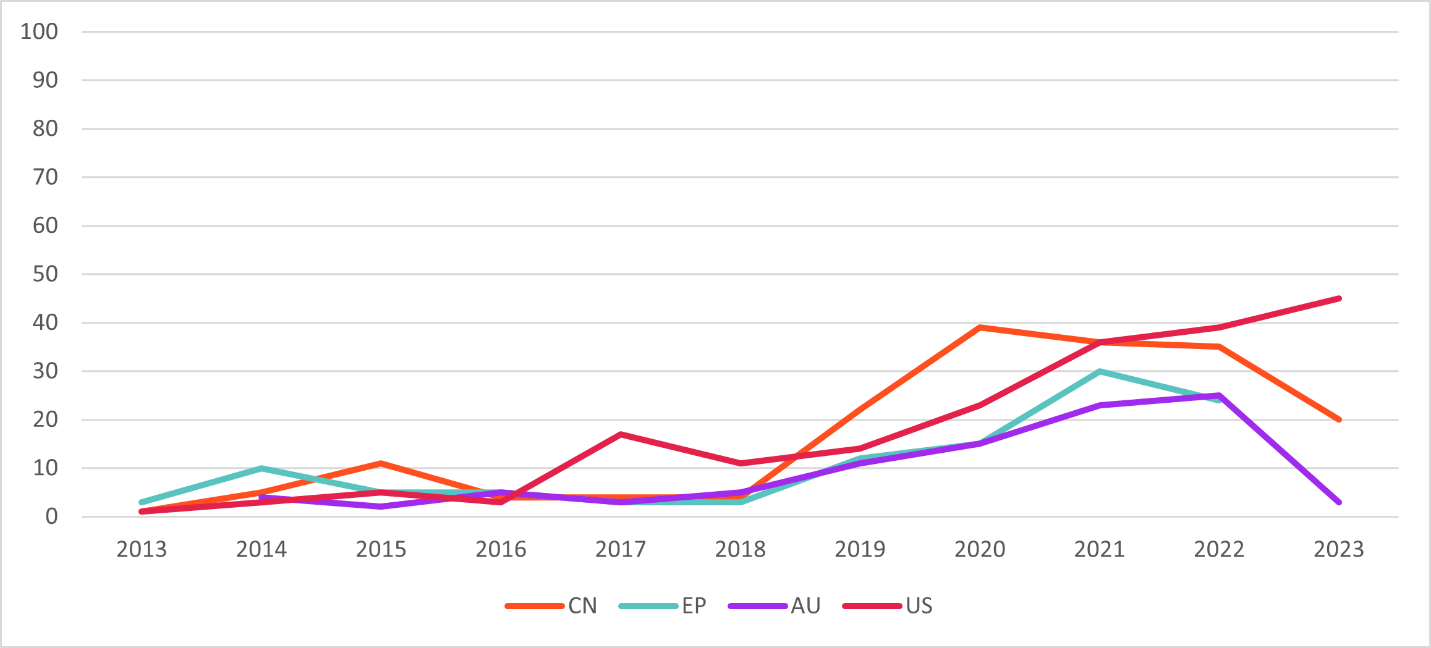[author: Aditi Das, Director]
In 2019, KFC dropped the unexpected into a frier and forever changed the quick-serve restaurant (QSR) industry. They teamed up with Beyond Meat, a leading plant-based meat company, to create a vegan chicken offering, which ignited an emerging trend in some of the largest QSR players across the globe offering plant-based proteins. Impossible Foods, another pioneer in alternative meats, established itself as a household name and quickly gobbled up market share through key partnerships with Starbucks, Disney restaurants, and Burger King. This trend in alternative protein is part environmental battle, part health battle, and now intellectual property battle as competition intensifies with companies jockeying for leadership position.
According to the Meat Substitutes Market Size & Trends report by Grand View Research, the global meat substitutes market was valued at $18.78 billion USD in 2023 and is expected to grow at a compound annual growth rate (CAGR) of 42.4% from 2024 to 2030. Driven by health, ethical, and environmental considerations, the alternative or cultured proteins sector is witnessing significant growth and is expected to become more accessible and lucrative as research and technological developments progress.
Substitute proteins for meat, egg and dairy are researched extensively to mimic their animal-based versions in terms of taste, aroma, and texture. They are broadly classified based on the method of preparation, which are:
- Plant-derived Protein: Products made from soy, wheat, pea protein, oats, and other plant-based ingredients.
- Cultured Protein: Also known as “lab-grown” or “cell-based meat/dairy,” where meat is produced by culturing animal cells in vitro using tissue engineering techniques.
- Fermented Proteins or Recombinant Proteins: Products made through precision fermentation using microorganisms to produce meat or dairy-like proteins and other compounds.
Patent landscaping the future of food
The patent landscape in alternative proteins is dynamic and rapidly expanding, showcasing the innovative and competitive nature of the sector. Companies are actively filing patents to protect their unique technologies, formulations, and processes, which are essential for developing products that meet consumer expectations for taste, texture, and sustainability.
Most patents granted in this sector revolve around the steps in precision fermentation, nucleotide and amino acid sequences for cultured proteins, and strains of host or expression organisms. Additionally, many patent filings cover methods to create meat-like or cheese-like textures from cultured proteins through extrusion and other mechanical processes, as well as ways to enhance the flavor and nutritional content of substituted proteins.
Geographic distribution:
The primary geographies for patent protection in the field are the U.S., Mainland China, Europe, and Australia. Approximately 30% of the patents filed in Mainland China and 50% of those filed in Europe are from U.S. based assignees, suggesting that the U.S. is at the forefront in developing commercial-grade cultured proteins.


Top players and their IP positions
Impossible Foods leads the industry’s patent race with over 300 IP assets filed in the past decade. These patents encompass various aspects of manufacturing, protein properties, and commercialization. Two companies following closely are Every Company (formerly Clara Foods), which specializes in animal-free and vegan egg proteins, and Perfect Day Inc., which focuses on recombinant dairy proteins.

Patent disputes and litigation:
As the industry expands, disputes over proprietary technologies and formulations will prompt companies to safeguard their IP to maintain a competitive advantage. As the methods of manufacturing alternative proteins gets standardized, we will likely see the patentability of amino acid sequences and expression vectors as big points of contention.
In a notable case, Motif FoodWorks initiated a review of a patent held by Impossible Foods after being sued for alleged patent infringement related to the use of heme in creating plant-based meat substitutes. This review, granted by the U.S. Patent and Trademark Office (USPTO), will assess the patentability of Impossible Foods’ patents. Similarly, Perfect Day is fighting patentability challenges in both the U.S. and Australia. Both cases underscore the complexities and legal intricacies involved in protecting IP within an emerging sector that is still evolving at fast pace.
Market Watch
A telltale sign of a rapidly expanding industry is the rise in partnerships and collaborations between emerging startups and established industry giants. We see this happening as Perfect Day Inc. partners with industry behemoths like Unilever, Nestle, ADM, and Bel Group. Or, as mentioned above, with Impossible Foods partnering with renowned brands like Disney, Burger King, Starbucks, and White Castle. These collaborations reflect the growing demand for sustainable and innovative food options and drive the integration of plant-based alternatives into mainstream markets.
Conclusion
The landscape of alternative protein technology from an intellectual property perspective is dynamic and multifaceted. As the industry expands, driven by consumer demand for sustainable and ethical food options, the importance of IP protection becomes crucial to the companies’ competitive positioning, value creation, and opportunities for growth.
Patent disputes and challenges over proprietary technologies and formulations are on the rise as companies strive to maintain a competitive edge in this evolving market. However, amidst these challenges, the proliferation of partnerships and collaborations between startups and established players underscores the industry’s potential for growth and innovation. By understanding the competitive field through data-driven insights, companies can better leverage IP rights to protect their innovations and forge strategic alliances. This opens more doors for companies to advance the development of alternative protein technologies and pave the way for a more sustainable and resilient food system.